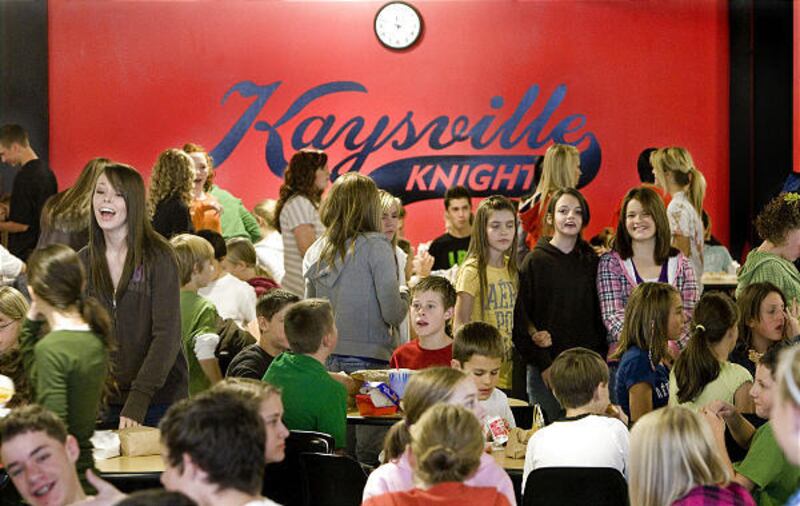One look at Kaysville Junior High School's hallways between classes brings the word "sardines" to mind.
The school is packed with 1,330 kids, 130 more than last year. Two more portable classrooms were brought in this fall for a total of 11.
The school added more lunch tables and scheduled three lunch sessions that run like clockwork. But seventh-grader Tiffany Carlton, 12, says it's still crowded. "Some kids sit on the floor," she said.
Kaysville Junior High and many other schools in Utah are feeling claustrophobic as state enrollment continues to escalate.
Utah's K-12 student population grew by 12,260 kids for a total 563,273 students this fall, a slightly more than 2 percent increase, according to preliminary data released Wednesday afternoon by the State Office of Education.
Utah charter school enrollment grew about 24 percent to 34,166 this fall from 27,369 last year and accounts for about 6 percent of the total public school enrollment.
The statewide data for the 2009-10 school year is based on the number of students enrolled on Oct. 1, or on the first full day of school after that date.
Enrollment numbers are used for state education funding via the weighted pupil unit formula. The Legislature held the WPU amount at $2,577 for this school year, the same amount as it distributed the previous year, despite student growth.
Ethnic minority student enrollment grew to 20.7 percent this fall from 19.8 percent last year. San Juan, Salt Lake and Ogden school districts are now majority-minority districts at 55.8 percent 55.3 percent and 54.3 percent, respectively.
School districts across Utah are experiencing and dealing with the growth in different ways.
Davis School District officials counted 65,452 students this fall, up 438 kids. And that was with a new charter school opening in the district and taking 475 students "which is really nice for us, actually, because it helps pull down our student population," said Superintendent Bryan Bowles.
Washington School District, down 573 kids, isn't as thrilled to lose roughly 600 students to a new charter school in the district. Student growth was actually up almost 2 percent but other factors weighed heavily in bringing the total down, such as emerging online high schools. The small growth, as compared to an 18 percent increase a few years ago, is due to the poor economy, according to Marshall Topham, assistant superintendent over secondary education. "We've had very little growth in our area," he said.
Granite School District is down 272 students although district officials are disputing the number, saying their own calculations show they are down 125 kids. With approximately 68,000 students, losing a couple hundred is actually less than 1 percent. "Our enrollment fluctuates year to year," said district spokesman Ben Horsley.
Granite is still the largest district in the state, followed by Davis and Alpine.
In Alpine District this fall there are 64,351 students, 3,128 more than last year. "Growth is happening all over our district, but it's booming in the west," said district spokeswoman Rhonda Bromley.
Alpine may be headed for a bond election, possibly in 2011 due to the mushrooming enrollment, she said. "We want to stay one step ahead of growth," Bromley said, adding the district will send out a survey soon to gauge residents' feelings on bond debt and tax increases.
Nebo School District counted 690 more students this fall, bringing it's total to 28,282 for the fall. District spokeswoman Lana Hiskey said growth is partially due to new housing development. "We're a bedroom community and there is a lot of property to build on," she said.
Duchesne School District grew by 78 students this fall for a total 4,436, despite a drop in oil the industry in the Uintah Basin.
"This was quite a surprise," said Dee Miles, district business administrator. "We expected a decline — not growth — after all the jobs that were lost over the past year."
Voters in Tuesday's election, however, downed Duchesne's $49 million bond proposal. The district wanted to build an additional elementary school and replace two high schools.
Davis District voters approved a $250 million bond proposal Tuesday. Part of the plan is to open a new junior high on Kaysville's west side in fall 2011. The new school would draw about 350 students from Kaysville and Fairfield junior high schools. Legacy Junior High opened up this fall with about 900 students.
"Buildings are us because kids are us," Bowles joked.
Kaysville Junior High seventh-grader Ashley Nielson, 12, said there is a positive side to growth at her school. "You get to meet a lot of other kids."
e-mail: astewart@desnews. TWITTER: AKStewDesNews

